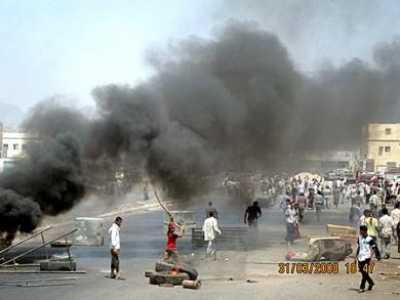|
|
|
|
Yemen has rounded up opposition political leaders in response to several days of riots that caused extensive damage to government buildings and vehicles. Over the last 48 hours, the Yemeni military deployed dozens of tanks, armored vehicles and fighter jets into the southern Yemeni governorates.
Riots broke out March 29. After a large rally in the governorate of Dhalie, southern youths angry at being excluded from the security forces, despite government promises, blocked main streets with burning tires. They also set fire to two police stations and numerous military vehicles. They brought a donkey to the local headquarters of President Saleh’s ruling party, the General People’s Congress. The rioters claim they were excluded from service because of regional bias.
The issue of regional discrimination is at the root of the demonstrations that have swept southern Yemen since May 2007. The protests are led by former southern military officers punitively discharged after Yemen’s 1994 civil war. Demonstrators charge that most jobs in the south are awarded to northerners, and southerners do not have equal rights or opportunities. Protesters increasingly chant slogans calling for “the liberation of southern Yemen” from northern “occupation,” in spite of the Yemeni regime’s previous declaration that chanting regional slogans is tantamount to treason.
Since May, 19 protesters have been killed by security forces. Hundreds were arrested. The former head of the Endowments Ministry, Naser Al-Shaibani, issued a fatwa during Eid services in October 2007 that the southern military retirees are disbelievers and not Muslims anymore.
The Yemeni government closed southern newspapers, blocked news Web sites and Matoob, the Arabic blogging platform. Al-Jazeera and other Arabic satellite channels were prohibited from filming the protests. International and local correspondents were repeatedly detained by security forces. The home of the editor of the popular al-Ayyam newspaper was riddled with gunfire, resulting in one fatality. However, the protests remained largely peaceful until now.
Tanks are positioned in major cities throughout the south. Fighter jets are making frequent passes. Security and military squads raided homes and political parties’ premises in Aden, Dhalei, Radfan, Abyan, and Mukalah. Dozens of opposition political figures were arrested at their homes at dawn Monday. Witnesses said the men were pulled from their bedrooms and beaten. Most are now incommunicado at various military camps.
Among the arrested are leaders of the Retired Army Association, including Abdu Al-Maatri, and Hassan Baoum, who already had been arrested in September, held incommunicado and released in December. Also reportedly arrested is Ali Munasar, the head of the Yemeni Socialist Party in Aden. The government claimed the residents of Dhahlie demanded the security forces strike the demonstrators with an iron fist.









5 Comments
Unfortunately, Northern and Southern Yemen can’t live with each other and can’t live without each other. It’s like a bad marriage that never ends.
Is there an ideological dimension to this? Or just regional or tribal?
Well some in the South believe the state in headed for failure in the short term and the only way to save even part of it is to split the nation into its two earlier incarnations. A civil war is unlikely considering the South is so outgunned. It would result in a bloodbath with no lasting progress. Many are hopng for international intervention which seems unlikely.
There is an ideological difference that arises from the two states’ history. North Yemen was ruled by the Imamate until 1962, largely secluded and very tribal. The South was first a British colony and then Marxist, so there are stronger traditions of a state and its administration. After unity, tribalism and extreme religious conservatism spread from the North to the South and many in the South resent this trend as a regression. However, its primarily about political and economic exclusion. The Southerners feel their history was erased and their accomplishments negated. Like many “emerging democracies”, Yemen is a dictatorship with democratic dressing. The power sharing that was to be the basis of the Unity of North and South Yemen never materialized.
Thanks for the additional info.
Curious if there are any good recomendations of regional history from perspective of British colonialism, WWII divisions between West and Soviet Stalin days.
Everything I’ve read so far shows the West or Brits at fault for carving up the lands and mixing tribes together.
But to often leaves out the Soviet era of influence under Stalins rule. Soviets come in often and fill a vacuum of power and friendship.
In the end, all of this benefits Russia today, chaos in Iran, Iraq, etc., fuel higher oil prices. Which is the only thing fueling Russia’s economy besides weapons sales.